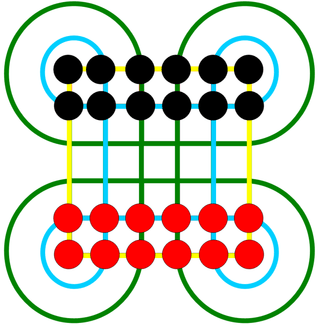Surakarta (game)

Surakarta is a little-known Indonesian strategy board game for two players, named after the ancient city of Surakarta in central Java. The game features an unusual method of capture which is "possibly unique" and "not known to exist in any other recorded board game".[1][2]
The real name of the game is permainan (meaning the game in Bahasa Indonesia).[3][4] In Java, the game is also called dam-daman. It was first published in France in 1970 as "Surakarta".[4] The game is called "Roundabouts" in Sid Sackson's The Book of Classic Board Games.[5]
Equipment
Traditionial Indonesian game pieces are shells versus pebbles or stones, with the board grid inscribed in sand or volcanic ash.[1][4] But any easily distinguished sets of pieces may be used (e.g. red versus black counters or checkers, as illustrated). Players begin the game with 12 pieces each.
Rules
Players decide who moves first, then turns alternate. The object of the game is to capture all 12 of the opponent's pieces; or if no further captures are possible, to have more pieces remaining on the board than the opponent.
Pieces always rest on the points of intersection of the board's grid lines. On a turn, a player either moves one of his pieces a single step to an unoccupied point in any direction (forwards, backwards, sideways, or diagonally), or makes a capturing move special to Surakarta.
Capturing move
A capturing move consists of traversing along an inner or outer circuit (colored blue or green in the illustration) around at least one of the eight corner loops of the board, followed by landing on an enemy piece, capturing it. Captured pieces are removed from the game.
So, corner loop(s) are only used when making a capture. The capturing piece enters (and leaves) the circular loop via a grid line tangent to the circle. Any number of unoccupied points may be traveled over, before or after traversing a corner loop. An unoccupied point may be traveled over more than once during the capturing piece's journey. Only unoccupied points may be traveled over; jumping over pieces is not permitted.
Capturing is always optional (never mandatory).
End of game
A game is won when a player captures all 12 of his opponent's pieces. If neither side can make headway, the game is ended by agreement and the winner is the player with the greater number of pieces remaining on the board.
Scoring
A match consists of more than one game. Players agree beforehand how the winner will be determined. A couple methods are typically used:
- Playing a fixed number of games
- Each game is scored by the number of pieces remaining at the end of the game. The winner is the player with higher total points after all games have finished.
- Playing to a fixed number of points
- New games are played until one player reaches or exceeds the winning point total.
Strategy
In general, pieces are more powerful toward the center of the board, where they are in one or two sets of loops. Pieces on the corner, on the other hand, are easy to trap, as the spaces next to the corner can be attacked in a number of directions.
Computer opponents
Surakarta is one of the games played regularly at the annual Computer Olympiad.
Variants
Surakarta variants are also among the traditional board games played in rural China and Korea, with slightly different rules and boards.[6][7][8][9][10] In these variants, pieces cannot step diagonally, and can slide along the outer circuit without capturing a piece.[11]
References
- 1 2 Bell (1983), p. 97.
- ↑ Pritchard (1994), p. 35.
- ↑ Glonnegger, E. (1988). Das Spielebuch. Ravensburg.
- 1 2 3 Gering (2003), p. 24.
- ↑ Sackson (1991), p. 12.
- ↑ 泰顺乡村棋类游戏 Taishun village board games
- ↑ 자동차 고누
- ↑ 자 전 거 고 누
- ↑ 물래고누
- ↑ 자동차고누
- ↑ gonu6-6.swf
Bibliography
- Bell, R. C. (1983). "Surakarta". The Boardgame Book. Exeter Books. ISBN 0-671-06030-9.
- Gering, Ralf (Summer 2003). Kerry Handscomb, ed. "Surakarta Problem". Abstract Games. Carpe Diem Publishing (14). ISSN 1492-0492.
- Pritchard, David (1994). "Surakarta". The Family Book of Games. Brockhampton Press. ISBN 1-86019-021-9.
- Sackson, Sid (1991). The Book of Classic Board Games. Klutz Press. ISBN 978-0-932592-94-1.
External links
| Wikimedia Commons has media related to Surakarta (board game). |